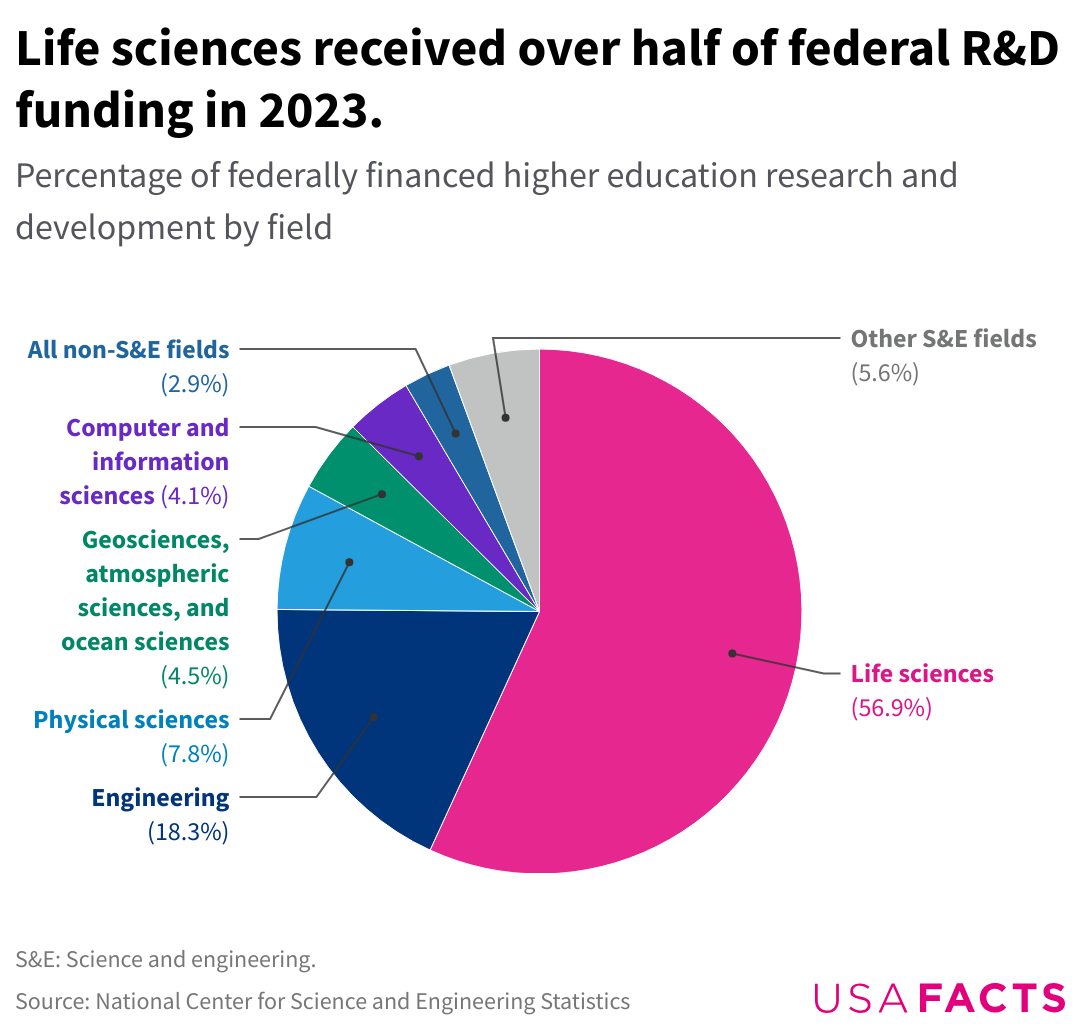The website USAFacts.org publishes fascinating data—to me, at least. I get regular email messages with clean graphics, frequently addressing questions I had never considered. A recent circular examining federal funding to universities was no exception.
(Fair disclosure: three relatives work at Johns Hopkins, although none is a researcher as such.)
Furthermore, the dollars primarily support study in the life sciences and engineering; these are rarely grants to support underwater cooking techniques for barbecue fish stands. Two years ago (the latest available data), federal grants were allocated across the following broad disciplines.
While Johns Hopkins is a top medical center, a higher percentage of its federal funding is allocated to engineering, accounting for 43% of the $3.38 billion the institution received from the federal government in 2023. The 27% of Hopkins’ funding in life sciences mirrors the majority of research medical programs associated with universities on this list.
Healthcare is a significant issue in this country due to our large population and the numerous health issues it presents. We have also had the envy of the world’s research, a private/public partnership spanning decades, to remediate, if not cure, those illnesses. However, healthcare done right is a prohibitively expensive proposition.
We have long since departed from an American economy built solely on the “free market,” if we ever had one. The intricate web of relationships between government funding and various institutions, including business, defense, education, and social services, among others, grew throughout the twentieth century but was hardly new, despite our rhetoric to the contrary. The Constitution’s Preamble, words I cite frequently in Actions Create Consequences, presaged that government-private partnership in saying.
“We, the People of the United States, to form a perfect Union, establish Justice, insure domestic Tranquility, provide for the common defense (sic), promote the general Welfare, and secure the Blessings of Liberty to ourselves and our Posterity, do ordain and establish this Constitution for the United States of America.”
The government, despite its many failures in the eyes of many, is integral to finding solutions to society’s problems, as it provides for the common defense and promotes the general welfare of its citizens. That is the basis for the spending, rather than a fanciful idea that government agencies create reasons to spend money without oversight or direction.
Federal expenditures to U.S. academic researchers have garnered much attention lately. The USAFacts.org explanation, however, of the focus for much of the money has real implications worth considering. The expenditures discussed here are grants (competitive applications) and contracts (commitments for a specific service or product the government requests). I do not follow the intricacies of the patent or regulatory worlds, which are so vital to transforming research into products that you and I use, but know they play an integral step in getting products and services in our hands as consumers. Still, the linkages between products in our daily lives and this funding over time are essential. The mere question of testing products is a lengthy and drawn-out process for federal or private sector investigators, fraught with challenges and governed by strict bureaucratic and ethical standards, all of which increase the costs involved yet are vital for any aspect of human health.
The Johns Hopkins University receives almost three times as much money as the next highest recipient, the University of Washington in Seattle. Known for its origins as the research hospital school in the United States, Hopkins recipients focus on engineering and life science research. Indeed, seventeen of the top twenty schools allocate the majority of their funding to life science research. Translate that into things relevant to our human welfare.
I am not saying that all of the projects (none of which are detailed here) are priorities for you or me, as I have no idea what specific conditions or ailments the research addresses. The competitive nature of grant-making theoretically addresses priorities.
But what will happen to health research as the federal government dramatically scales down its expenditures today? Since I am unaware of the specific projects the investigators at these schools are pursuing, I can only speculate.
I am pretty confident, however, that with an aging population, a sharp increase in obesity (by 2030, half of the U.S. population may fall under the category entitled obesity, defined as individuals with a body mass index—imperfect as that measure for health, scientists use is as a benchmark for comparison’s sake—above 30. Estimates are that fully a quarter of the population will confront severe obesity with their index at 35 or higher), with coincident increases in blood pressure, diabetes, and linked conditions; a substantial portion of the research addressed those chronic diseases, if for no other reason that that’s where the money is in the future of health care. Similarly, as climate change alters our living experience, allergies increase, along with the invasion of various insect-borne diseases, all of which will frequently require more medical attention.
Who will fund the research as federal sources dry up in the face of our shifting political landscape? I have no specific cases to cite, nor do I know for sure what the final legislation will contain when the president signs the budget for fiscal year 2026.
The trend, however, in federal spending for anything other than defense is in decline due to our massive federal debt and a shift in mentality at the Department of Health & Human Services from trusting expertise to anecdote-based preferences. The Department is the single largest funding source for medical studies in the United States if not the globe. Where DHS goes, so goes our health system.
Yet the implications may not be evident to you and me this afternoon.
It’s simple to assume that medicine, a term as ubiquitous and indefinite as “government bureaucracy,” will pick up the responsibility. However, a fundamental and seemingly unnoticed difference between the government and the private sector is that the latter is directly responsible to shareholders for profits. In contrast, the government is never intended to generate profits. The effect of these two radically different perspectives plays into the options all of us will have five or fifty years from now.
In a laissez-faire, free market system, the government can challenge, coax, encourage, or hope for the private sector’s commitment to research on a particular disease or an antidote to chikungunya, a severe illness transmitted by mosquitoes, regardless of border walls or political proclamation. The private companies, however, are not legally responsible to us as citizens but to their shareholders. Many of them may pursue medical research on relevant concerns but will do so to advance their corporate interests. I do not say that in a snarky manner but, as a matter of fact, in a free market.
Without government research funding, a knock-on effect will be to discourage students from studying in areas where they can garner financial support. It may tempt many who view academics as underemployed. Still, an aspiring graduate student or new professor must pay the bills and wants the means to plan for the future, especially if they desire a family, like anyone else. One of the reasons the United States prospered so well in the past century was the unparalleled research, particularly in the health sciences and engineering, done at universities across the country, not merely those in the chart above. The lack of funding for those students will mean that the best and brightest will go elsewhere, such as to Europe or China, both of which are willing to invest state resources in the fields, luring them away. That draw, too, is the magic of the free market, where capital and knowledge migrate to meet better conditions; much of this is also true for any business.
Simply pledging that we deserve their efforts here, in the face of attacks on their work, intentions, institutional affiliations, and character, will never suffice to keep them here. As someone who taught for more than 40 years, I care deeply about our intellectual pipeline for the benefits it brings rather than simply because it’s what I did for so long. The ramifications, however, are for those exploring the field now, entering or eschewing it for the remainder of this century. What cures will we miss because Mónica Windstorm Rosarioja, Elmer Carrie Jones, or someone else chooses to pursue another field or go elsewhere to apply their expertise?
The implications of the changes underway in our country are much more profound than we appreciate at this stage. As long-term readers are aware, I do not oppose cutting the debt, as I view it as a sword of Damocles hanging over us as a nation. However, we do not recognize the effects that clearing academic research is bound to create.
I hope you will be one of the “educated consumers,” as a local discount house used to preach in their television adverts for decades on this subject. Weigh in with your elected representatives, pro or con; I want engagement rather than sleepwalking into stupidity because we feel overwhelmed by the magnitude of change. Demand our government explain its priorities, then respond by endorsing or objecting as they do hear us.
I welcome thoughts on this column or any topic I cover in Actions Create Consequences as I genuinely seek expanded, measured civil conversation. I especially thank the subscribers who support this column with their resources, allowing me to follow materials I could not otherwise. A monthly subscription is $8, while a year’s commitment is $55.
It’s every bit as raw, windy, and heavy rain as we had at any point over the past year along Spa Creek. Today’s photograph of an unusual shade of honeysuckle resulted from our Eastport walkabout yesterday when it was cloudy but hardly the monsoon we have this morning.
Be well and be safe. FIN
Eric Finkelstein, Olga Khavjou, Hope Thompson, Justin Trogdon, Liping Pan, Bettylou Sherry, and William Dietz, “Obesity and Severe Obesity Forecasts through 2030”, American Journal of Preventative Medicine, 42: 6 (563-570), 2012, retrieved at https://www.ajpmonline.org/article/S0749-3797(12)00146-8/fulltext
Jeff Minerd, “Half of U.S. Adults Obese by 2030”, Medpage.com, 18 December 2019, retrieved at https://www.medpagetoday.com/endocrinology/obesity/83987
“Preamble”, Constitution.Congress.gov, 1787, retrieved at https://constitution.congress.gov/constitution/preamble/
USA Facts.org, “How universities use federal funding“, USAFacts.org, 27 May 2025, retrieved at https://manage.kmail-lists.com/subscriptions/web-view?a=SH8aQb&c=01J8QTNVNKPXNTVA7RPFC67CFJ&k=76b0e1d447222c6cdf1202dfc5ff1df2&m=01JW9DHQBA58NQB5447PHMYY6G&r=01JWA878PBCCWDBMZP6RV5B3M9






